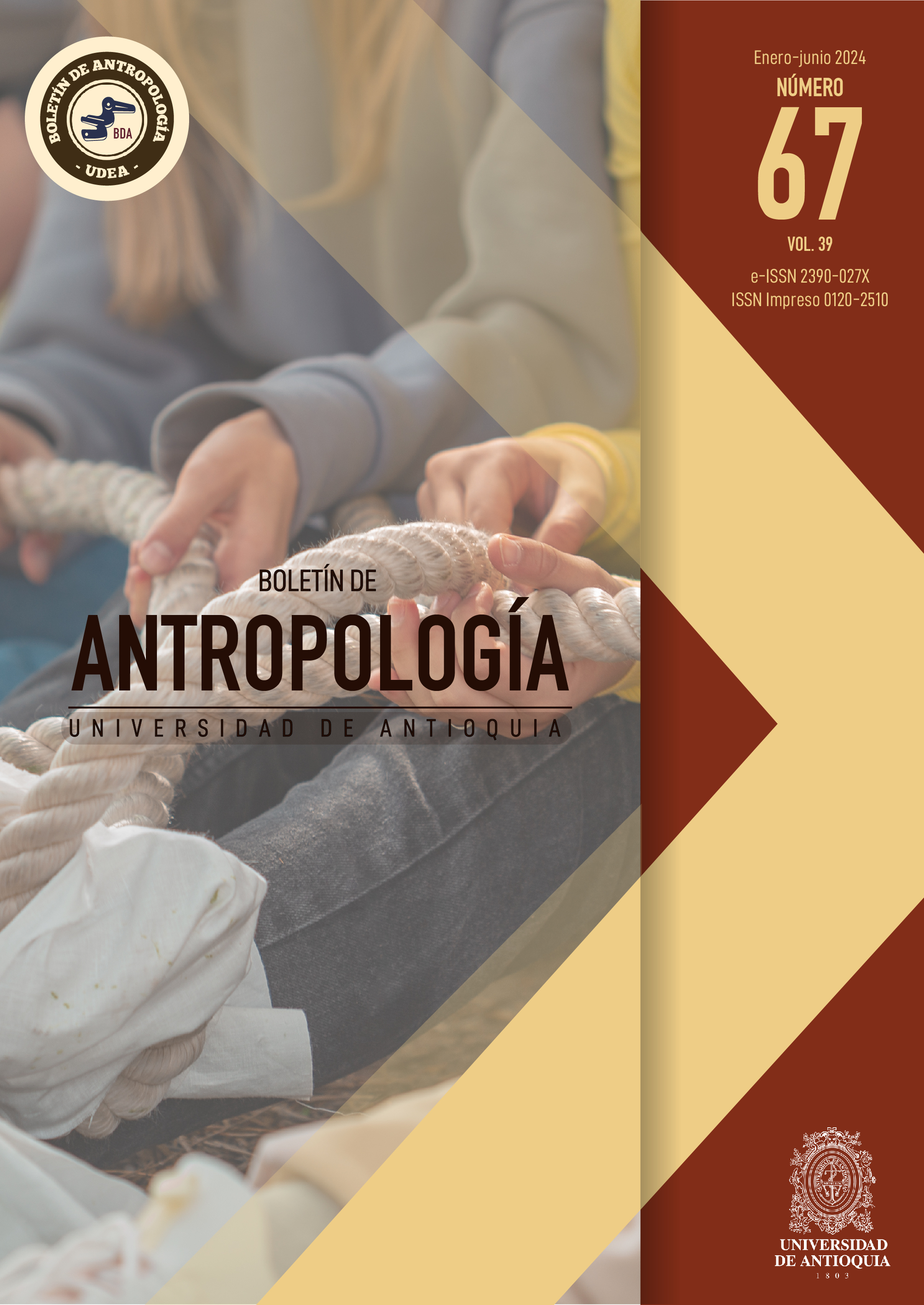Spatializing emotions. Participatory emotional cartographies of young women who inhabit spaces of violence in Mexico City
DOI:
https://doi.org/10.17533/udea.boan.v39n67a9Keywords:
Spatialization of emotions, emotional cartographies, young women, inhabited space, urban violence, genderAbstract
In this article I present the experience of co-generating a participatory methodology, based mainly on social mapping and ethnography, to elaborate emotional maps of spaces considered dangerous in Mexico City, from a gender perspective and in the midst of the restrictions imposed by the Covid-19 pandemic. The need for this methodology is framed in a research that I undertook, during the year 2021, in which I sought to investigate the relationship between emotions, inhabited space and violence in the daily lives of young women. The findings of this research show how emotions spatialize and re-signify the inhabited space, reorganize the geography and the urban layout based on the daily, corporal and emotional experience of the young women who inhabit it.
Downloads
References
Ahmed, Sara. La política cultural de las emociones. Programa Universitario de Estudios de Género, UNAM, Ciudad de México, 2015.
Barragán León, Andrea. Cartografía social de la cultura local del departamento de la Guajira. Editorial Gobernación de la Guajira y Fondo Mixto de Cultura, Riohacha, Colombia, 2018.
Calderón, Edith. “El papel de la dimensión afectiva en la adquisición del lenguaje materno.” Alteridades 53, no. 27 (2017): 11-22. [En línea:] https://www.scielo.org.mx/scielo.php?script=sci_arttext&pid=S0188-70172017000100011.
Cano, Héctor. “Barrio Norte en Álvaro Obregón, más peligroso que Tepito: PGJ.” Excelsior, June 6, 2019. [En línea:] https://www.excelsior.com.mx/comunidad/barrio-norte-en-alvaro-obregon-mas-peligroso-que-tepito-pgj/1334866 (accessed May 25, 2021).
Cozzi, Eugenia, Enrique Font, and María E. Mistura. “Desprotegidos y sobrecriminalizados. Interacciones entre jóvenes de sectores populares, policía provincial y una fuerza de seguridad nacional en un barrio de la ciudad de Rosario.” Revista InfoJus no. 8 (2015): 3-30. [En línea:] http://www.saij.gob.ar/eugenia-cozzi-desprotegidos-sobrecriminalizados-interaccionesentre-jovenes-sectores-populares-policia-provincial-una-fuerza-seguridad-nacional-barrio-ciudad-rosario-dacf150281-2014-12/123456789-0abc-defg1820-51fcanirtcod.
Czytajlo, Natalia. “Género, ciudad y violencia(s). Territorialidades y cartografías emergentes.” Revista Nodo 14, no. 28 (2020): 41-57. DOI: https://doi.org/10.54104/nodo.v14n28.175.
Debord, Guy. “Teoría de la deriva.” In Internacional situacionista, vol. I: La realización del arte. Literatura Gris, Madrid, 1958. [En línea:] https://sindominio.net/ash/is0209.htm.
Del Valle, Teresa. Andamios para una nueva ciudad. Lecturas desde la antropología. Cátedra, Madrid, 1997.
Del Valle, Teresa. “Capítulo 5. El derecho a la movilidad libre y segura.” In Mujeres, globalización y derechos humanos, edited by Virginia Maquieira, 245-291. Cátedra, Madrid, 2006.
Durán, María Ángeles. La ciudad compartida: conocimiento, afecto y uso. Consejo Superior de los Colegios de Arquitectos de España, Madrid, 1998.
Fals Borda, Orlando. Ciencia propia y colonialismo intelectual. Los nuevos rumbos. Carlos Valencia Editores, Bogotá, 1987.
Giglia, Ángela. El habitar y la cultura. Perspectivas teóricas y de investigación. Anthropos, Barcelona, 2012.
Instituto Nacional de Estadística y Geografía (INEGI). “Mortalidad.” INEGI, México, 2020. [En línea:] https://www.inegi.org.mx/temas/mortalidad/ (accessed October 29, 2020).
Kern, Leslie. Ciudad feminista. La lucha por el espacio en un mundo diseñado por hombres. Ediciones Godot, Colombia, 2020.
Lan, Diana. “Género y violencia: una ostentación de género en cada concepto.” In Espaço, gênero y poder: conectando Ponteras, edited by Joseli María Silva and Augusto César Pinhero da Silva, 121-136. Todapalabra Editora, Brasil, 2011.
Le Bretón, David. “Por una antropología de las emociones.” Revista Latinoamericana de Estudios sobre Cuerpos, Emociones y Sociedad 4, no. 10 (2012): 67-77. [En línea:] https://www.redalyc.org/pdf/2732/273224904006.pdf.
Leivas Vargas, Monique, Alejandra Boni Aristizábal, and Montse Mendoza Crespo. “Del cuerpo a la ciudad: repensando nuestros territorios desde la investigación colectiva con cartografía social.” Kultur. Revista Interdisciplinària sobre la Cultura de la Ciutat 4, no. 8 (2017): 169-190. [En línea:] https://doi.org/10.6035/Kult-ur.2017.4.8.6.
Lindón, Alicia. “La construcción socioespacial de la ciudad: el sujeto cuerpo y el sujeto sentimiento.” Cuerpos, Emociones y Sociedad 1, no. 1 (2009): 06-20. https://doi.org/10.19053/01233769.10548
Lindón, Alicia. “La periferia: fragmentos inestables de la ciudad vivida.” Perspectiva Geográfica 2, no. 25 (2020): 15-33. [En línea:] http://www.scielo.org.co/pdf/pgeo/v25n2/0123-3769-pgeo-25-02-15.pdf.
Massey, Doreen. Space, Place and Gender. Polity Press, Cambridge, 1994.
Massolo, Alejandra. Por amor y coraje. Mujeres en movimientos urbanos de la ciudad de México. PIEM, El Colegio de México, Ciudad de México, 1992. https://doi.org/10.2307/j.ctvhn0b41
Massolo, Alejandra. Una mirada de género a la ciudad de México. UAM-Azcapotzalco / Red Nacional de Investigación Urbana, Ciudad de México, 2004.
Oslender, Ulrich. “Espacio e identidad en el Pacífico colombiano.” In De montes, ríos y ciudades, edited by Juana Camacho and Eduardo Restrepo, 25-48. Fundación Natura, ECOFONDO, Instituto Colombiano de Antropología, Santa Fe de Bogotá, 1999.
Rich, Adrianne. Sangre, pan y poesía. Icaria Editorial, Barcelona, 2001.
Rodó-Zárate, María. Interseccionalidad. Desigualdades, lugares y emociones. Ediciones Bellatierra, Manresa, 2021.
Saraví, Gonzalo. “Youth Experience of Urban Inequality: Space, Class, and Gender in Mexico.” In Handbook of Children and Youth Studies, Springer Science+Business Media Singapore, Estados Unidos, 2014, 503-515. https://doi.org/10.1007/978-981-4451-15-4_45
Soto, Paula. “El miedo de las mujeres a la violencia en la Ciudad de México. Una cuestión de justicia espacial.” Revista Invi 27, no. 75 (2012): 145-169. https://doi.org/10.4067/S0718-83582012000200005
Soto, Paula. “Entre los espacios del miedo y los espacios de la violencia. Discursos y prácticas en la corporalidad y las emociones.” In Cuerpos, espacios y emociones: aproximaciones desde las ciencias sociales, edited by Miguel Ángel Aguilar and Paula Soto, 197-219. Miguel Ángel Porrúa / UAM-Iztapalapa, Ciudad de México, 2013.
Soto, Paula. “Repensar el hábitat urbano desde la perspectiva de género. Debates, agendas y desafíos.” Andamios 13, no. 32 (2016): 37-56. https://doi.org/10.29092/uacm.v13i32.524
Published
How to Cite
Issue
Section
License
Copyright (c) 2024 María Laura Serrano Santos

This work is licensed under a Creative Commons Attribution-NonCommercial-ShareAlike 4.0 International License.
Authors who publish in the Bulletin of Anthropology accept the following conditions:
- Authors retain copyright and yield the right of first publication to the journal, with the work registered with Creative Commons attribution license, which allows third parties to use what was published as long as the authorship of the work and the first publication in this magazine are mentioned.
- Authors can perform other independent and additional contractual arrangements for the non - exclusive distribution of the version of the article published in this issue (E.g. Inclusion in an institutional repository or publish it in a book), as long as it is clearly indicated that the work was published for the first time in this magazine.












